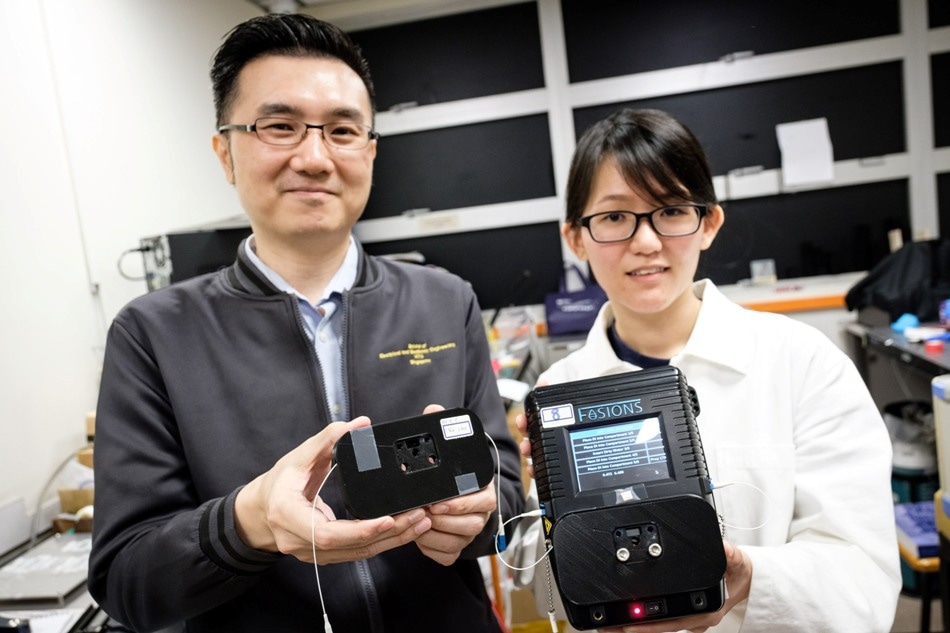Apr 16 2019
Inspired by the potential of the human body, a research team at Nanyang Technological University, Singapore (NTU Singapore) has created a new, portable device to detect very small levels of heavy metals present in drinking water, all in just a fraction of minutes.
 Device inspired by human body’s metal sensing mechanism (Image credit: Nanyang Technological University, Singapore)
Device inspired by human body’s metal sensing mechanism (Image credit: Nanyang Technological University, Singapore)
The key matter is an organic substance found within the circulating human bloodstream, known as a chelating agent. This agent is capable of detecting and adhering to heavy metal ions.
Post binding, it inhibits the heavy metal ions from communicating with other enzymes and molecules present in the body, and labels it for removal from the body.
Integrating an optical measurement system with a chelating agent, Professor Tjin Swee Chuan and Associate Professor Yong Ken-Tye from the School of Electrical and Electronic Engineering created a novel device that rapidly produces test results without the need to bring back samples. This makes the device easy for on-site water testing. Moreover, it can also be incorporated into appliances for domestic applications, like water filtration systems.
The quality of drinking water is usually checked through laboratory tests because heavy metals cannot be simply detected by odor, taste, or color, unless they are present in concentrated amounts. Although laboratory tests are extremely precise, they require at least a single day to complete.
A few portable devices are available on the market that are capable of detecting heavy metal contaminants in a rapid manner; however, these instruments may demand the extra step of combining a buffer solution with the water sample prior to performing the test. Moreover, the sensor meant for such kinds of kits needs to be used within a period of 30 minutes upon its exposure to air, because the sensor’s effectiveness can be influenced by humidity, heat, or air.
Other portable substitutes include those that utilize metal electrodes, for example, mercury as a sensing probe, which can potentially affect the environment by introducing heavy metal contaminants back into it. There are also test strips that vary in color upon coming into contact with heavy metals but they tend to give results that depend heavily on the subjective readings of the strip.
Now, the latest device developed by the NTU team is designed to work in the field and in this instrument, only a few drops of a water sample have to be added into a disposable sensor cartridge to identify heavy metals at parts-per-billion accuracy. The results of the study have been reported in the scientific journal, ACS Sensors.
Such a level of sensitivity corresponds with Singapore’s safety limit requirements that fall within the standards stipulated by World Health Organization. For example, the device is capable of detecting lead levels of 5 parts per billion, which is considerably lower than the 10 parts per billion limit specified by Singapore’s Environmental Public Health Act. In addition, the sensor’s sensitivity in the NTU portable device is not restricted by exposure to air, and it continues to be effective to about a temperature of 40 °C.
Our device is capable of conducting on-site water quality tests quickly and can detect up to 24 types of metal contaminants, which is double the capacity of other commercially available water sensors. Using a chelating agent in the device ensures that its sensor is as sensitive in detecting heavy metals as the body’s natural defence mechanism against metal intoxication.
Yong Ken-Tye, Associate Professor and Chair, School of Electrical and Electronic Engineering, Nanyang Technological University
Inspired by the body’s metal sensing mechanism
The device features an optical fiber sensor customized with a chelating agent, as well as a laser that illuminates through it. The optical fiber sensor is linked to a processing unit that shows the outcomes of the water quality test.
The metal ions within a water sample contaminated by heavy metals will adhere to the chelating agent present on the optical fiber sensor. This causes a change in the output light spectrum, from which the processing unit of the device subsequently computes the concentration of heavy metals present in the sample. It takes five minutes to do this process.
The device can easily be integrated into any existing in-line water treatment plant. While our product is competitive enough to penetrate the market, we are still working to enhance and expand our water sensor product line. For instance, we are exploring ways to translate this technology for domestic use, such as in domestic water filtration systems and electric water kettles.
Professor Tjin Swee Chuan, Associate Provost, Graduate Education & Lifelong Learning, Nanyang Technological University
The NTU researchers have already filed for two patents and now they have effectively established a spin-off company, Waterply, which is presently working with other local firms to gather more information via the team’s invention to enhance the device’s precision.
Waterply is also teaming up with a state-owned company based in China to create sophisticated water sensors that can address water pollution.
The study was supported by NTU’s Nanyang Environment and Water Research Institute (NEWRI), and NTUitive, NTU’s innovation, and enterprise company.